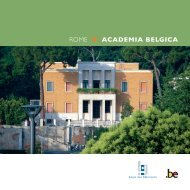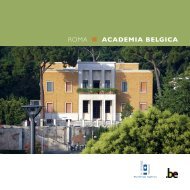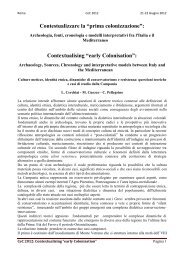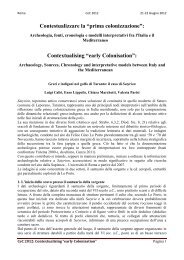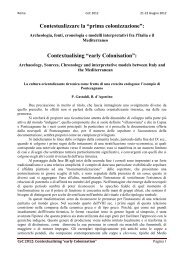Esthetics and Spirituality: Places of Interiority - Academia Belgica
Esthetics and Spirituality: Places of Interiority - Academia Belgica
Esthetics and Spirituality: Places of Interiority - Academia Belgica
Create successful ePaper yourself
Turn your PDF publications into a flip-book with our unique Google optimized e-Paper software.
CALL FOR PAPERS<br />
Deadline: 1 December 2012<br />
Conference<br />
<strong>Esthetics</strong> <strong>and</strong> <strong>Spirituality</strong>: <strong>Places</strong> <strong>of</strong> <strong>Interiority</strong><br />
Katholieke Universiteit Leuven, Belgium<br />
16 – 17 – 18 May 2013<br />
In the contemporary Western European world traditional, institutionalized religions are losing ground,<br />
while alternative religions, literature <strong>and</strong> the arts, film <strong>and</strong> media, as well as commercial enterprises are<br />
<strong>of</strong>fering alternatives. Old concepts, symbols <strong>and</strong> rituals are translated into new forms. This is a recurrent<br />
phenomenon: as sensitivities change throughout the ages, the ways to express this changed “interiority”<br />
change <strong>and</strong> result in new manifestations <strong>of</strong> spirituality.<br />
This multi‐ <strong>and</strong> interdisciplinary Conference on Aesthetics <strong>and</strong> <strong>Spirituality</strong> looks at how, both in the past<br />
<strong>and</strong> the present, people devise(d) new ways <strong>of</strong> conceiving <strong>and</strong> manifesting interiority. In order to look at<br />
the forms “interiority” has received throughout the ages we use different approaches: literature, cultural<br />
studies, theology, art (iconography/iconology), history (<strong>of</strong> ideas) <strong>and</strong> architecture, anthropology, political<br />
sciences/sociology, psychology, philosophy...<br />
How do exteriority <strong>and</strong> interiority relate? What does it mean to be in a place, to be at home in the world or<br />
with oneself (cf Pierre Nora, Les lieux de mémoire)? How can urban planning, public <strong>and</strong> private buildings,<br />
furniture <strong>and</strong> other material things, clothes, prescribed attitudes, etc. be conducive to interiorization<br />
(conscious or unconscious reflections, contemplation)? Or, conversely, how can material factors repress<br />
interiority (cf repressive political systems)? In order to imagine a topology <strong>of</strong> interiority that would draw on<br />
an inter‐disciplinary field <strong>of</strong> studies <strong>and</strong> research we invite papers on the different kinds <strong>of</strong> language which<br />
translate outside to inside <strong>and</strong> vice versa.<br />
If interiority is a question <strong>of</strong> presence <strong>and</strong> orientation we need to look at<br />
(a) Bodily expressions: a religious community prescribed a certain body language which could bring<br />
about a spirituality (cf. nineteenth‐century feminine congregations focusing on nursing, weaving <strong>and</strong><br />
embroidering); manifold forms <strong>of</strong> biblical spirituality (Schneider et al) inspire the body, while psychology <strong>of</strong><br />
religion <strong>and</strong> psychoanalysis develop ways <strong>of</strong> reading religious bodies (Vergote, Lacan, Vasse, Moyaert et al).<br />
(b) Expressions through things, images (iconology), words:<br />
‐changes in the attitude to relics, books, icons, devotional cards, rosaries, …<br />
‐different links between theology, art <strong>and</strong> literature produce different forms: the “bondieuserie” in France<br />
(1850s) differed from Pre‐Raphaelite depictions <strong>of</strong> the divine (criticized by Dickens), or from the Pilgrim’s<br />
Movement in Fl<strong>and</strong>ers; after the Great War Benedictine spirituality was revived, while Franciscan<br />
spirituality brought a new attention for nature <strong>and</strong> animals in literature; 21st‐century ecocriticism brings a<br />
new attitude to representations <strong>of</strong> nature, as do gender studies to aspects <strong>of</strong> spirituality …<br />
(c) Changes in Ritual, as a means to link physical <strong>and</strong> metaphysical aspects <strong>of</strong> experience: which<br />
forms <strong>of</strong> ritual are depicted, developed, in contemporary literature, to mark forgiveness, reconciliation, or<br />
other transitions (to adulthood, married life, divorce, healing from sickness, death,…) Which theories <strong>of</strong><br />
performativity are used in liturgy these days? Which kind <strong>of</strong> poetics are used in contemporary prayer? How<br />
do contemporary political symbols (fail to) develop? (Cf. prevalence <strong>of</strong> Christian symbols in<br />
commemorations <strong>of</strong> British army casualties et al). Can ritual help in conflict situations, <strong>and</strong> how are new<br />
rituals validated? How do religious institutions relate to the secularization?<br />
(d) Contributions relating to or focusing on Irish topics will be especially welcomed.<br />
Are Celtic symbols still known, used, adapted? How does Irish urbanization, architecture, make space for<br />
interiority? How is “interiority” conceived at all in contemporary art <strong>and</strong> philosophy? Which places,
moments, figures, phenomena, concepts, does contemporary film, drama, poetry, fiction, art, hold in<br />
special reverence? Does nature (stone, plant, animal) still harbour something sacred, <strong>and</strong> if so, how? Do<br />
angels still figure?<br />
Are there still references to the Jewish, Greek, Christian stories? Is twentieth‐century <strong>and</strong> contemporary<br />
art, literature <strong>and</strong> film reacting or indifferent to this tradition, does it translate archaic symbols (animals<br />
<strong>and</strong> trees, food <strong>and</strong> drink, textile <strong>and</strong> books, home <strong>and</strong> travel, …) into new forms, or does it divest these old<br />
icons <strong>of</strong> their symbolism?<br />
The conference is hosted by the KU Leuven, the Faculties <strong>of</strong> the Arts, Theology <strong>and</strong> KADOC (Interfaculty<br />
Institute <strong>of</strong> the KU Leuven for Documentation <strong>and</strong> Research for Religion, Culture <strong>and</strong> Society) in<br />
cooperation with the Leuven Centre for Irish Studies (LCIS). It will take place in the newly refurbished Irish<br />
college in Leuven (the Leuven Institute for Irel<strong>and</strong> in Europe). The Scientific Committee consists <strong>of</strong> Barbara<br />
Baert (KU Leuven, Arts), Reimund Bieringer (KU Leuven, Theology), Ralph De Koninck (Université Catholique<br />
de Louvain, Arts), Jan De Maeyer (KADOC, KU Leuven, History/Heritage), Borbala Farago (Central European<br />
University Budapest, Gender Studies), Veerle Fraeters (U Antwerpen, Literature), Christine Göttler<br />
(Universität Bern, Arts), Hedwig Schwall (KU Leuven/Kortrijk, Literature), Paul V<strong>and</strong>enbroeck (KU Leuven/<br />
Anthropology/Social sciences), Henrik von Aachen (University <strong>of</strong> Bergen, Norway, Arts)<br />
Papers should not exceed 2500‐3000 words (20 minutes’ delivery). Proposals for papers (250 words) <strong>and</strong> a<br />
short biography should be sent by e‐mail to<br />
Hedwig Schwall , Hedwig.schwall@arts.kuleuven.be<br />
You will be notified by 20 December.<br />
More information about the conference will be posted on www.irishstudies.kuleuven.be/



